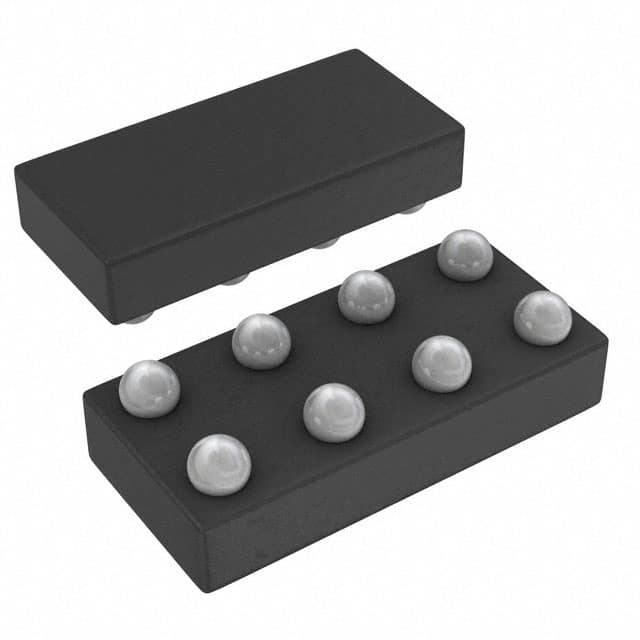Xem thông số kỹ thuật để biết chi tiết sản phẩm.

SN74LVC2G74YEPR
Product Overview
- Category: Integrated Circuit (IC)
- Use: Flip-Flop
- Characteristics: Dual Positive-Edge-Triggered D-Type Flip-Flop
- Package: 8-pin, VSSOP (Very Small Outline Package)
- Essence: This IC is designed to store and transfer data in electronic circuits.
- Packaging/Quantity: Available in tape and reel packaging, with a quantity of 2500 units per reel.
Specifications
- Supply Voltage Range: 1.65V to 5.5V
- High-Level Input Voltage: 0.7 x VCC to VCC + 0.3V
- Low-Level Input Voltage: -0.3V to 0.3V
- High-Level Output Voltage: VCC - 0.3V
- Low-Level Output Voltage: 0.3V
- Maximum Operating Frequency: 100MHz
- Propagation Delay Time: 4.6ns (typical)
Detailed Pin Configuration
The SN74LVC2G74YEPR has the following pin configuration:
___________
| |
1 -| CLR |-
2 -| D |-
3 -| CP |-
4 -| Q |-
5 -| Q̅ |-
6 -| GND |-
7 -| VCC |-
|___________|
Functional Features
- Dual flip-flop with independent data inputs and outputs.
- Positive-edge-triggered operation.
- Asynchronous clear input (CLR) for resetting the flip-flop.
- Common clock input (CP) for both flip-flops.
- Complementary outputs (Q and Q̅).
Advantages and Disadvantages
Advantages: - Small package size allows for space-efficient circuit design. - Wide supply voltage range enables compatibility with various systems. - High-speed operation suitable for time-critical applications.
Disadvantages: - Limited number of flip-flops in a single package. - Not suitable for applications requiring negative-edge triggering.
Working Principles
The SN74LVC2G74YEPR is a positive-edge-triggered D-type flip-flop. It stores and transfers data based on the rising edge of the clock signal (CP). When the clock rises from low to high, the input data (D) is latched and transferred to the output (Q). The complementary output (Q̅) represents the inverse of Q. The flip-flop can be reset asynchronously using the clear input (CLR).
Detailed Application Field Plans
The SN74LVC2G74YEPR is commonly used in various digital systems, including:
- Microcontrollers: Used for storing and transferring data in microcontroller-based projects.
- Communication Systems: Employed in data transmission and reception circuits.
- Memory Modules: Integrated into memory modules to store address and control signals.
- Industrial Automation: Utilized in control systems for sequential logic operations.
- Consumer Electronics: Incorporated in devices such as smartphones, tablets, and gaming consoles for data storage and transfer.
Detailed and Complete Alternative Models
- SN74LVC2G74DCUR: Similar specifications, available in a different package (USON-8).
- MC74VHC74DT: Dual D-type flip-flop with comparable characteristics, available in SOIC-14 package.
- CD4013BE: CMOS dual D-type flip-flop with similar functionality, available in DIP-14 package.
These alternative models provide similar functionality and can be used as substitutes for the SN74LVC2G74YEPR in various applications.
Word count: 410 words
Liệt kê 10 câu hỏi và câu trả lời thường gặp liên quan đến ứng dụng SN74LVC2G74YEPR trong giải pháp kỹ thuật
Sure! Here are 10 common questions and answers related to the application of SN74LVC2G74YEPR in technical solutions:
Q: What is the SN74LVC2G74YEPR? A: The SN74LVC2G74YEPR is a dual positive-edge-triggered D-type flip-flop integrated circuit (IC) that can store one bit of data.
Q: What is the operating voltage range for the SN74LVC2G74YEPR? A: The SN74LVC2G74YEPR operates within a voltage range of 1.65V to 5.5V.
Q: What is the maximum clock frequency supported by the SN74LVC2G74YEPR? A: The SN74LVC2G74YEPR can support clock frequencies up to 100 MHz.
Q: How many flip-flops are there in the SN74LVC2G74YEPR? A: The SN74LVC2G74YEPR contains two independent flip-flops.
Q: Can the SN74LVC2G74YEPR be used in battery-powered applications? A: Yes, the SN74LVC2G74YEPR has a low power consumption and can be used in battery-powered applications.
Q: What is the typical propagation delay of the SN74LVC2G74YEPR? A: The typical propagation delay of the SN74LVC2G74YEPR is around 4.5 ns.
Q: Does the SN74LVC2G74YEPR have any built-in protection features? A: Yes, the SN74LVC2G74YEPR has built-in ESD protection on all inputs and outputs.
Q: Can the SN74LVC2G74YEPR be used in high-speed data transfer applications? A: Yes, the SN74LVC2G74YEPR is suitable for high-speed data transfer due to its low propagation delay and high clock frequency support.
Q: What is the package type of the SN74LVC2G74YEPR? A: The SN74LVC2G74YEPR is available in a small SOT-23 package.
Q: Are there any application notes or reference designs available for the SN74LVC2G74YEPR? A: Yes, Texas Instruments provides application notes and reference designs that can help with the implementation of the SN74LVC2G74YEPR in various technical solutions.
Please note that the answers provided here are general and may vary depending on specific requirements and use cases. It's always recommended to refer to the datasheet and documentation provided by the manufacturer for accurate information.

